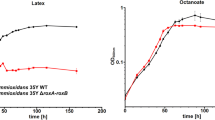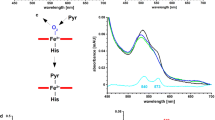Abstract
The utilization of rubber (poly (cis-1,4-isoprene)) by rubber-degrading bacteria depends on the synthesis of rubber oxygenases that cleave the polymer extracellularly to low molecular weight products that can be taken up and used as a carbon source. All so far described Gram-negative rubber-degrading species use two related ≈ 70 kDa rubber oxygenases (RoxA and RoxB) for the primary attack of rubber while all described Gram-positive rubber-degrading strains use RoxA/RoxB-unrelated latex-clearing proteins (Lcps, ≈ 40 kDa) as rubber oxygenase(s). In this study, we identified an lcp orthologue in a Gram-negative species (Solimonas fluminis). We cloned and heterologously expressed the lcp gene of S. fluminis HR-BB, purified the corresponding Lcp protein (LcpHR-BB) from recombinant Escherichia coli, and biochemically characterised the LcpHR-BB activity. LcpHR-BB cleaved polyisoprene to a mixture of C20 and higher oligoisoprenoids at a specific activity of 1.5 U/mg. Furthermore, spectroscopic investigation identified LcpHR-BB as a b-haem-containing protein with an oxidised, fivefold coordinated (open) haem centre. To the best of our knowledge, this is the first report that Gram-negative bacteria can have an active rubber oxygenase of the Lcp type.





Similar content being viewed by others
References
Andler R, Steinbüchel A (2017) A simple, rapid and cost-effective process for production of latex clearing protein to produce oligopolyisoprene molecules. J Biotechnol 241:184–192. https://doi.org/10.1016/j.jbiotec.2016.12.008
Andler R, Altenhoff A-L, Mäsing F, Steinbüchel A (2018a) In vitro studies on the degradation of poly (cis-1,4-isoprene). Biotechnol Prog 78:4543–4899. https://doi.org/10.1002/btpr.2631
Andler R, Hiessl S, Yücel O, Tesch M, Steinbüchel A (2018b) Cleavage of poly (cis-1,4-isoprene) rubber as solid substrate by cultures of Gordonia polyisoprenivorans. New Biotechnol 44:6–12. https://doi.org/10.1016/j.nbt.2018.03.002
Arenskötter M, Baumeister D, Berekaa MM, Pötter G, Kroppenstedt RM, Linos A, Steinbüchel A (2001) Taxonomic characterization of two rubber degrading bacteria belonging to the species Gordonia polyisoprenivorans and analysis of hyper variable regions of 16S rDNA sequences. FEMS Microbiol Lett 205:277–282
Berry EA, Trumpower BL (1987) Simultaneous determination of hemes-a, hemes-b, and hemes-c from pyridine hemochrome spectra. Anal Biochem 161:1–15
Birke J, Jendrossek D (2014) Rubber oxygenase and latex clearing protein cleave rubber to different products and use different cleavage mechanisms. Appl Environ Microbiol 80:5012–5020. https://doi.org/10.1128/AEM.01271-14
Birke J, Röther W, Schmitt G, Jendrossek D (2013) Functional identification of rubber oxygenase (RoxA) in soil and marine Myxobacteria. Appl Environ Microbiol 79:6391–6399. https://doi.org/10.1128/AEM.02194-13
Birke J, Röther W, Jendrossek D (2015) Latex clearing protein (Lcp) of Streptomyces sp. strain K30 is a b-type cytochrome and differs from rubber oxygenase A (RoxA) in its biophysical properties. Appl Environ Microbiol 81:3793–3799. https://doi.org/10.1128/AEM.00275-15
Birke J, Röther W, Jendrossek D (2017) RoxB is a novel type of rubber oxygenase that combines properties of rubber oxygenase RoxA and latex clearing protein (Lcp). Appl Environ Microbiol 83:e00721–e00717. https://doi.org/10.1128/AEM.00721-17
Birke J, Röther W, Jendrossek D (2018) Rhizobacter gummiphilus NS21 has two rubber oxygenases (RoxA and RoxB) acting synergistically in rubber utilisation. Appl Microbiol Biotechnol 241:184–113. https://doi.org/10.1007/s00253-018-9341-6
Bode HB, Kerkhoff K, Jendrossek D (2001) Bacterial degradation of natural and synthetic rubber. Biomacromolecules 2:295–303. https://doi.org/10.1021/bm005638h
Braaz R, Fischer P, Jendrossek D (2004) Novel type of heme-dependent oxygenase catalyzes oxidative cleavage of rubber (poly-cis-1,4-isoprene). Appl Environ Microbiol 70:7388–7395. https://doi.org/10.1128/AEM.70.12.7388-7395.2004
Braaz R, Armbruster W, Jendrossek D (2005) Heme-dependent rubber oxygenase RoxA of Xanthomonas sp. cleaves the carbon backbone of poly (cis-1,4-isoprene) by a dioxygenase mechanism. Appl Environ Microbiol 71:2473–2478. https://doi.org/10.1128/AEM.71.5.2473-2478.2005
Brendtsen JD, Nielsen H, Widdick D, Palmer T, Brunak S (2005) Prediction of twin-arginine signal peptides. BMC Bioinformatics 6(1):167. https://doi.org/10.1186/1471-2105-6-16
Chia K-H, Nanthini J, Thottathil GP, Najimudin N, Haris MRHM, Sudesh K (2014) Identification of new rubber-degrading bacterial strains from aged latex. Polym Degrad Stab 109:354–361. https://doi.org/10.1016/j.polymdegradstab.2014.07.027
Coenen A, Oetermann S, Steinbüchel A (2019) Identification of LcpRBA3(2), a novel regulator of lcp expression in Streptomyces coelicolor A3(2). Appl Microbiol Biotechnol 7:e50562–e50512. https://doi.org/10.1007/s00253-019-09896-8
Heisey RM, Papadatos S (1995) Isolation of microorganisms able to metabolize purified natural rubber. Appl Environ Microbiol 61:3092–3097
Hiessl S, Schuldes J, Thuermer A, Halbsguth T, Broeker D, Angelov A, Liebl W, Daniel R, Steinbüchel A (2012) Involvement of two latex-clearing proteins during rubber degradation and insights into the subsequent degradation pathway revealed by the genome sequence of Gordonia polyisoprenivorans strain VH2. Appl Environ Microbiol 78:2874–2887. https://doi.org/10.1128/AEM.07969-11
Hiessl S, Boese D, Oetermann S, Eggers J, Pietruszka J, Steinbüchel A (2014) Latex clearing protein-an oxygenase cleaving poly (cis-1,4-isoprene) rubber at the cis double bonds. Appl Environ Microbiol 80:5231–5240. https://doi.org/10.1128/AEM.01502-14
Ibrahim E, Arenskötter M, Luftmann H, Steinbüchel A (2006) Identification of poly (cis-1,4-isoprene) degradation intermediates during growth of moderately thermophilic actinomycetes on rubber and cloning of a functional lcp homologue from Nocardia farcinica strain E1. Appl Environ Microbiol 72:3375–3382. https://doi.org/10.1128/AEM.72.5.3375-3382.2006
Ilcu L, Röther W, Birke J, Brausemann A, Einsle O, Jendrossek D (2017) Structural and functional analysis of latex clearing protein (Lcp) provides insight into the enzymatic cleavage of rubber. Sci Rep 7:6179. https://doi.org/10.1038/s41598-017-05268-2
Imai S, Ichikawa K, Muramatsu Y, Kasai D, Masai E, Fukuda M (2011) Isolation and characterization of Streptomyces, Actinoplanes, and Methylibium strains that are involved in degradation of natural rubber and synthetic poly (cis-1,4-isoprene). Enzym Microb Technol 49:526–531. https://doi.org/10.1016/j.enzmictec.2011.05.014
Imai S, Yoshida R, Endo Y, Fukunaga Y, Yamazoe A, Kasai D, Masai E, Fukuda M (2013) Rhizobacter gummiphilus sp. nov., a rubber-degrading bacterium isolated from the soil of a botanical garden in Japan. J Gen Appl Microbiol 59:199–205
Jendrossek D, Birke J (2018) Rubber oxygenases. Appl Microbiol Biotechnol 78:4543–4518. https://doi.org/10.1007/s00253-018-9453-z
Jendrossek D, Reinhardt S (2003) Sequence analysis of a gene product synthesized by Xanthomonas sp. during growth on natural rubber latex. FEMS Microbiol Lett 224:61–65
Jendrossek D, Tomasi G, Kroppenstedt RM (1997) Bacterial degradation of natural rubber: a privilege of actinomycetes? FEMS Microbiol Lett 150:179–188
Kasai D, Imai S, Asano S, Tabata M, Iijima S, Kamimura N, Masai E, Fukuda M (2017) Identification of natural rubber degradation gene in Rhizobacter gummiphilus NS21. Biosci Biotechnol Biochem 81:614–620. https://doi.org/10.1080/09168451.2016.1263147
Lee Y, Lee B, Lee K, Jeon CO (2018) Solimonas fluminis sp. nov., isolated from a freshwater river. Int J Syst Evol Microbiol 68:2755–2759. https://doi.org/10.1099/ijsem.0.002865
Linh DV, Huong NL, Tabata M, Imai S, Iijima S, Kasai D, Anh TK, Fukuda M (2017) Characterization and functional expression of a rubber degradation gene of a Nocardia degrader from a rubber-processing factory. J Biosci Bioeng 123:412–418. https://doi.org/10.1016/j.jbiosc.2016.11.012
Linh DV, Gibu N, Tabata M, Imai S, Hosoyama A, Yamazoe A, Kasai D, Fukuda M (2019) Complete genome sequence of natural rubber-degrading, gram-negative bacterium, Rhizobacter gummiphilus strain NS21T. Biotechnol Rep (Amst) 22:e00332. https://doi.org/10.1016/j.btre.2019.e00332
Linos A, Steinbüchel A, Spröer C, Kroppenstedt RM (1999) Gordonia polyisoprenivorans sp. nov., a rubber-degrading actinomycete isolated from an automobile tyre. Int J Syst Bacteriol 49(Pt 4):1785–1791. https://doi.org/10.1099/00207713-49-4-1785
Linos A, Berekaa MM, Steinbüchel A, Kim KK, Sproer C, Kroppenstedt RM (2002) Gordonia westfalica sp. nov., a novel rubber-degrading actinomycete. Int J Syst Evol Microbiol 52:1133–1139. https://doi.org/10.1099/00207713-52-4-1133
Nanthini J, Ong SY, Sudesh K (2017) Identification of three homologous latex-clearing protein (lcp) genes from the genome of Streptomyces sp. strain CFMR 7. Gene 628:146–155. https://doi.org/10.1016/j.gene.2017.07.039
Oetermann S, Vivod R, Hiessl S, Hogeback J, Holtkamp M, Karst U, Steinbüchel A (2018) Histidine at position 195 is essential for association of heme-b in Lcp1VH2. Earth Syst Environ 2:5–14. https://doi.org/10.1007/s41748-018-0041-2
Oetermann S, Jongsma R, Coenen A, Keller J, Steinbüchel A (2019) LcpRVH2 - regulating the expression of latex-clearing proteins in Gordonia polyisoprenivorans VH2. Microbiology (Reading, Engl) 56:269–354. https://doi.org/10.1099/mic.0.000755
Rose K, Steinbüchel A (2005) Biodegradation of natural rubber and related compounds: recent insights into a hardly understood catabolic capability of microorganisms. Appl Environ Microbiol 71:2803–2812. https://doi.org/10.1128/AEM.71.6.2803-2812.2005
Rose K, Tenberge KB, Steinbüchel A (2005) Identification and characterization of genes from Streptomyces sp. strain K30 responsible for clear zone formation on natural rubber latex and poly (cis-1,4-isoprene) rubber degradation. Biomacromolecules 6:180–188. https://doi.org/10.1021/bm0496110
Röther W, Austen S, Birke J, Jendrossek D (2016) Molecular insights in the cleavage of rubber by the latex-clearing-protein (Lcp) of Streptomyces sp. strain K30. Appl Environ Microbiol 82:6593–6602. https://doi.org/10.1128/AEM.02176-16
Röther W, Birke J, Grond S, Beltran JM, Jendrossek D (2017a) Production of functionalized oligo-isoprenoids by enzymatic cleavage of rubber. Microb Biotechnol 43:1238–1433. https://doi.org/10.1111/1751-7915.12748
Röther W, Birke J, Jendrossek D (2017b) Assays for the detection of rubber oxygenase activities. Bio-protocol 7:1–14. https://doi.org/10.21769/BioProtoc.2188
Schmitt G, Seiffert G, Kroneck PMH, Braaz R, Jendrossek D (2010) Spectroscopic properties of rubber oxygenase RoxA from Xanthomonas sp., a new type of dihaem dioxygenase. Microbiology (Reading, Engl) 156:2537–2548. https://doi.org/10.1099/mic.0.038992-0
Seidel J, Schmitt G, Hoffmann M, Jendrossek D, Einsle O (2013) Structure of the processive rubber oxygenase RoxA from Xanthomonas sp. Proc Natl Acad Sci U S A 110:13833–13838. https://doi.org/10.1073/pnas.1305560110
Sharma V, Siedenburg G, Birke J, Mobeen F, Jendrossek D, Prakash T (2018) Metabolic and taxonomic insights into the Gram-negative natural rubber degrading bacterium Steroidobacter cummioxidans sp. nov., strain 35Y. PloS One 13(5):e0197448. https://doi.org/10.1371/journal.pone.0197448
Tsuchii A, Takeda K (1990) Rubber-degrading enzyme from a bacterial culture. Appl Environ Microbiol 56:269–274
Warneke S, Arenskötter M, Tenberge KB, Steinbüchel A (2007) Bacterial degradation of poly (trans-1,4-isoprene) (gutta percha). Microbiology (Reading, Engl) 153:347–356. https://doi.org/10.1099/mic.0.2006/000109-0
Watcharakul S, Röther W, Birke J, Umsakul K, Hodgson B, Jendrossek D (2016) Biochemical and spectroscopic characterization of purified latex clearing protein (Lcp) from newly isolated rubber degrading Rhodococcus rhodochrous strain RPK1 reveals novel properties of Lcp. BMC Microbiol 16:92. https://doi.org/10.1186/s12866-016-0703-x
Yikmis M, Steinbüchel A (2012a) Historical and recent achievements in the field of microbial degradation of natural and synthetic rubber. Appl Environ Microbiol 78:4543–4551. https://doi.org/10.1128/AEM.00001-12
Yikmis M, Steinbüchel A (2012b) Importance of the latex-clearing protein (Lcp) for poly (cis-1,4-isoprene) rubber cleavage in Streptomyces sp K30. Microbiologyopen 1:13–24. https://doi.org/10.1002/mbo3.3
Acknowledgements
We thank the Weber and Schaer Company (Hamburg) for providing polyisoprene.
Funding
This work was supported by a grant of the Deutsche Forschungsgemeinschaft to D. J.
Author information
Authors and Affiliations
Corresponding author
Ethics declarations
Conflict of interest
The authors declare that they have no conflict of interest.
Ethic approval
This article does not contain any studies with human participants or animals performed by any of the authors.
Additional information
Publisher’s note
Springer Nature remains neutral with regard to jurisdictional claims in published maps and institutional affiliations.
Rights and permissions
About this article
Cite this article
Birke, J., Jendrossek, D. Solimonas fluminis has an active latex-clearing protein. Appl Microbiol Biotechnol 103, 8229–8239 (2019). https://doi.org/10.1007/s00253-019-10085-w
Received:
Revised:
Accepted:
Published:
Issue Date:
DOI: https://doi.org/10.1007/s00253-019-10085-w




